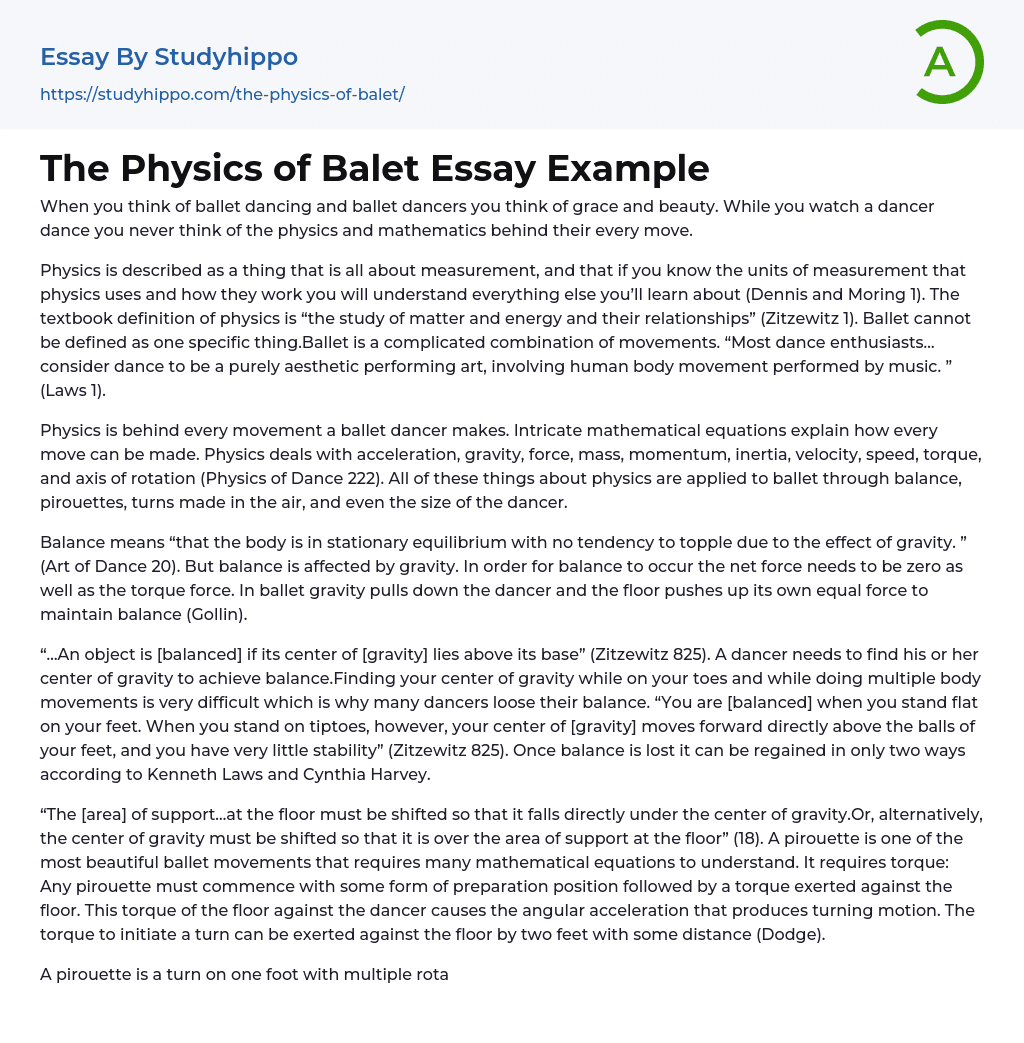When you think of ballet dancing and ballet dancers you think of grace and beauty. While you watch a dancer dance you never think of the physics and mathematics behind their every move.
Physics is described as a thing that is all about measurement, and that if you know the units of measurement that physics uses and how they work you will understand everything else you’ll learn about (Dennis and Moring 1). The textbook definition of physics is “the study of matter and energy and their relationships” (Zitzewitz 1). Ballet cannot be defined as one specific thing.Ballet is a complicated combination of movements. “Most dance enthusiasts…consider dance to be a purely aesthetic performing art, involving human body movement performed by music. ” (Laws 1).
Physics is behind every movement a ballet dancer makes. Intrica
...te mathematical equations explain how every move can be made. Physics deals with acceleration, gravity, force, mass, momentum, inertia, velocity, speed, torque, and axis of rotation (Physics of Dance 222). All of these things about physics are applied to ballet through balance, pirouettes, turns made in the air, and even the size of the dancer.
Balance means “that the body is in stationary equilibrium with no tendency to topple due to the effect of gravity. ” (Art of Dance 20). But balance is affected by gravity. In order for balance to occur the net force needs to be zero as well as the torque force. In ballet gravity pulls down the dancer and the floor pushes up its own equal force to maintain balance (Gollin).
“…An object is [balanced] if its center of [gravity] lies above its base” (Zitzewitz 825). A dancer need
to find his or her center of gravity to achieve balance.Finding your center of gravity while on your toes and while doing multiple body movements is very difficult which is why many dancers loose their balance. “You are [balanced] when you stand flat on your feet. When you stand on tiptoes, however, your center of [gravity] moves forward directly above the balls of your feet, and you have very little stability” (Zitzewitz 825). Once balance is lost it can be regained in only two ways according to Kenneth Laws and Cynthia Harvey.
“The [area] of support…at the floor must be shifted so that it falls directly under the center of gravity.Or, alternatively, the center of gravity must be shifted so that it is over the area of support at the floor” (18). A pirouette is one of the most beautiful ballet movements that requires many mathematical equations to understand. It requires torque: Any pirouette must commence with some form of preparation position followed by a torque exerted against the floor. This torque of the floor against the dancer causes the angular acceleration that produces turning motion. The torque to initiate a turn can be exerted against the floor by two feet with some distance (Dodge).
A pirouette is a turn on one foot with multiple rotations.Not only does it require torque but it also requires control of rotational velocity. “[Rotational velocity] comes from the arms, the torso, and the leg lifting” (Missaghi). When a dancer makes a turn in the air there are “no forces except gravity that can act on the dancer. Angular momentum stays constant: changing [rotational inertia] (by changing the orientation of
arms, legs,..
. ) will change [angular velocity] correspondingly” (Gollin) “,,,angular velocity…is the angle rotated per unit time…” (Zitzewitz 818). The size of the dancer also makes a huge difference when trying to make the movements ballet calls for.Rotational inertia is proportional to the mass of an object. “The acceleration of an object as produced by a net force is directly proportional to the magnitude of the net force, in the same direction as the net force, and inversely proportional to the mass of the object. ”(Madrid) In order to rotate faster you much decrease rotational inertia by decreasing mass or by making sure that the body is very close to the rotational axis (Fermilab).
There is a future for dance and physics being brought together as one. The Middlebury Campus even has a course dedicated to only physics and dance.Works Consulted Dennis, Johnnie T. , and Gary Moring.
The Complete Idiots Guide to Physics. 2nd ed. Indianapolis, IN: Penguin Group, 2004. Dodge, Sheila. "Physics of Ballet-intro.
" 2 Apr 2008 <http://www. geocities. com/capecanaveral/hangar/4421/#Rotational_Mechanics_and_the_Pirouette>. Fermilab, Natalia.
"Physics of dance. " 26 Apr 2003. 2 Apr 2008 <http://ed. fnal.
gov/trc_new/demos/present/physofballet. pdf>. Gollin, George. "Physics and Dance. " 21 June 2000. 2 Apr 2008 <http://www.
hep. uiuc. edu/home/g-gollin/dance/dance_physics. html#5>. Laws, Kenneth. The Physics of Dance.
New York: Schirmer Books, 1984. Physics and the Art of Dance: Understanding Movement. New York: Oxford University Press, 2002 Laws, Kenneth, and Cynthia Harvey. Physics, Dance and the Pas de Deux.
New York: Schirmer Books, 1994. Madrid, Willie. "The Laws of Physics. " 9 Apr 2008 <http://www. norcalhitting. com/Articles/laws_of_physics.
htm>. Missaghi, Mariam. "The Physics of Toe Shoes. " 2008. 2 Apr 2008 <http://www. the-perfect-pointe.
com/PointeShoePhysics. html>. Zitzewitz, Paul W. Glencoe Physics : Principles and Problems. Columbus, OH: The McGraw-Hill Companies, Inc.
, 2002.
- Atom essays
- Big Bang Theory essays
- Density essays
- Electricity essays
- Energy essays
- Force essays
- Heat essays
- Light essays
- Motion essays
- Nuclear Power essays
- Physiology essays
- Sound essays
- Speed essays
- Temperature essays
- Thermodynamics essays
- Automobile essays
- Bus essays
- Civil engineering essays
- Cycling essays
- Electric Car essays
- Genetic Engineering essays
- Hybrid essays
- Innovation essays
- Internal Combustion Engine essays
- Invention essays
- Mechanical Engineering essays
- Mechanics essays
- Software Engineering essays
- Telephone essays




